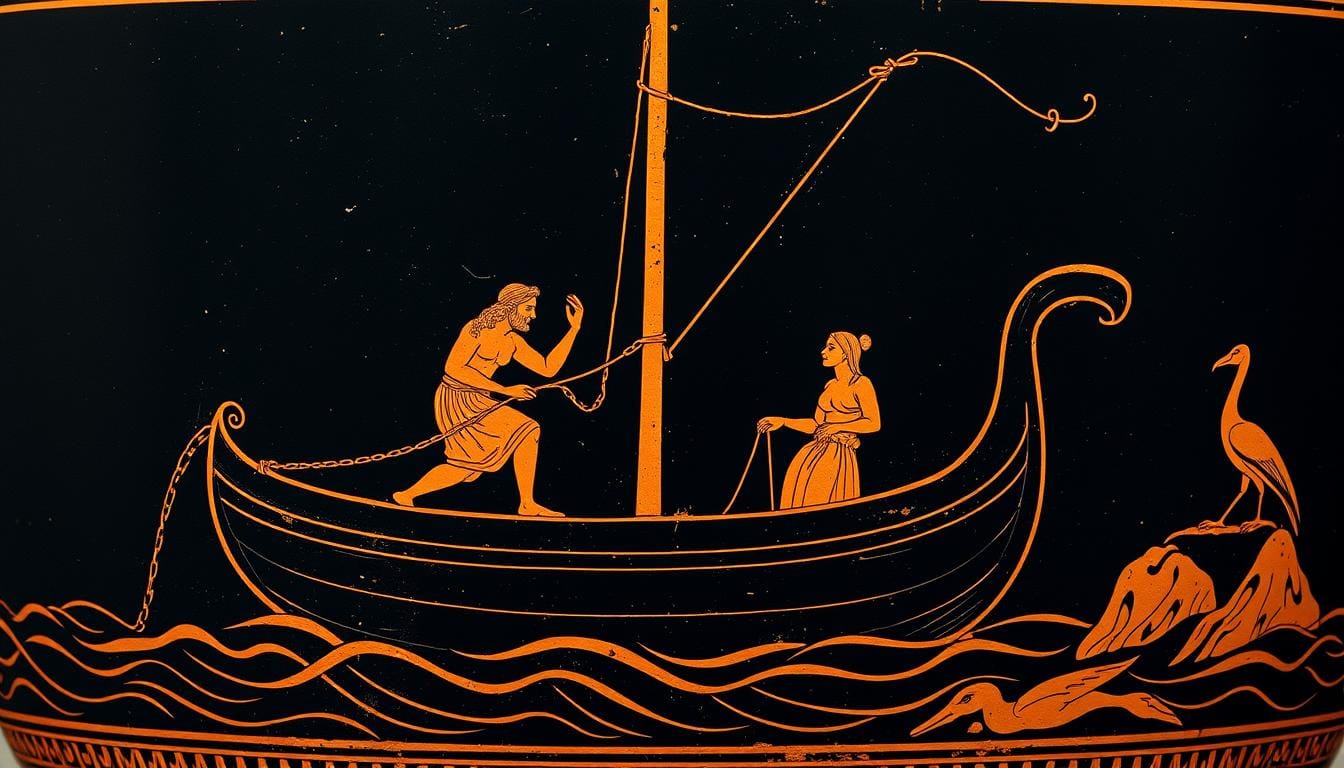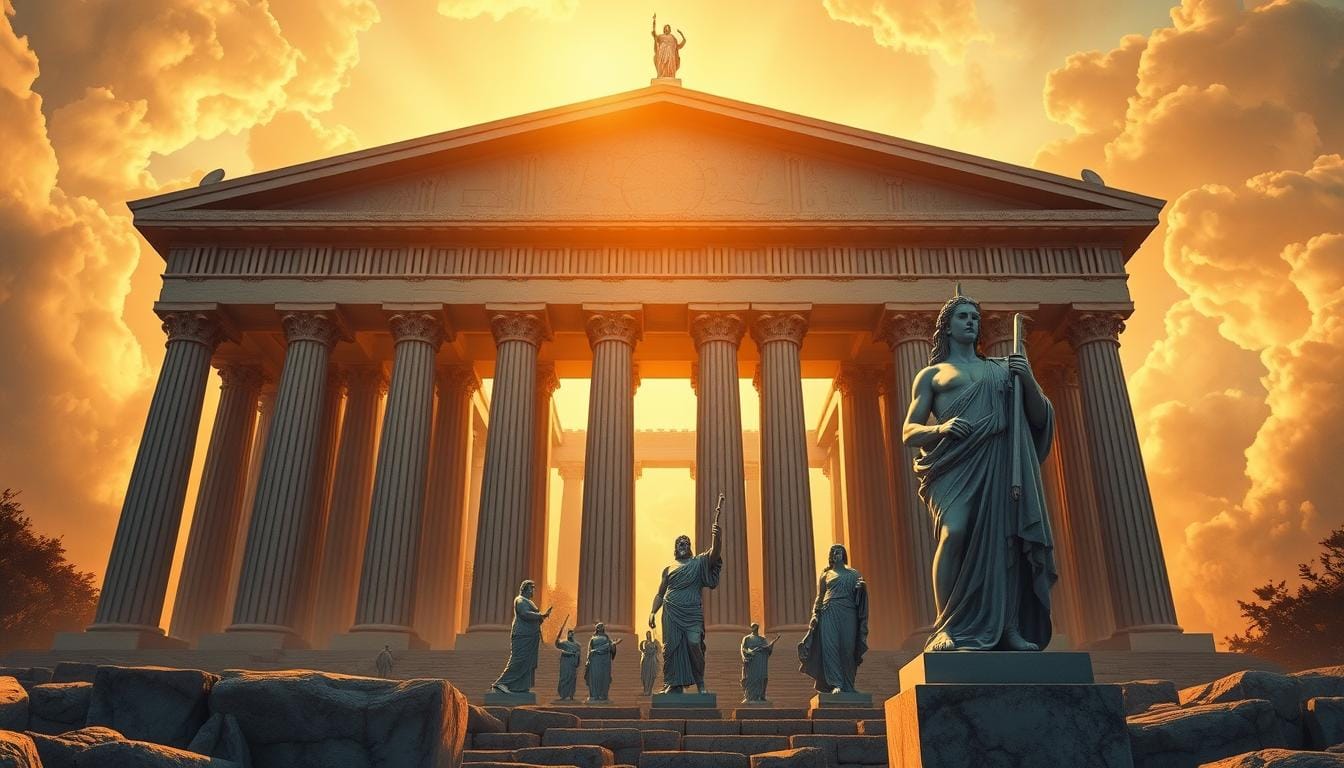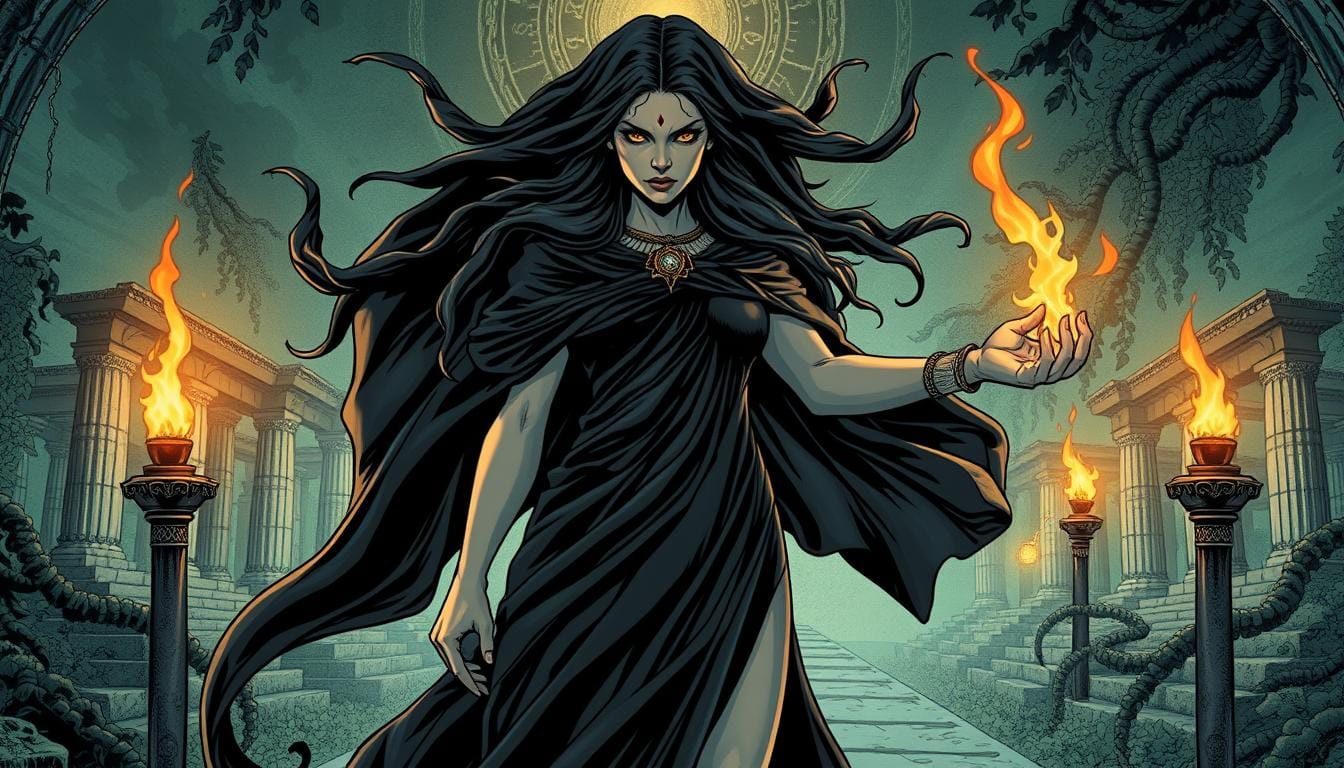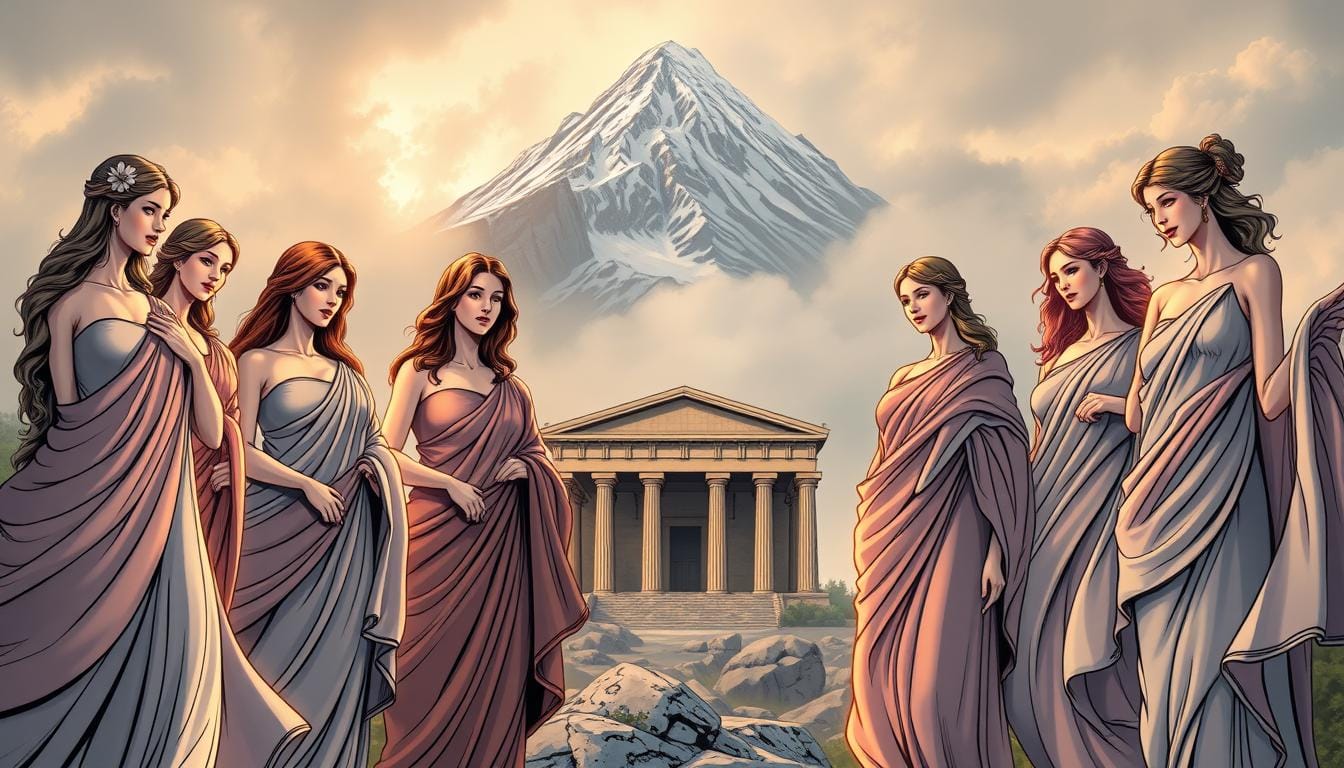Over 40 different cultures across the globe have their own stories about divine hammers. These stories show how much we love mythological weapons and the gods who use them.
In Norse halls and Greek temples, legendary weapons have amazed people for thousands of years. They are not just tools for fighting. They show the power and authority of the gods.
Thor’s hammer, Mjolnir, brings storms to life. Poseidon’s trident rules the seas. Each weapon has its own story, showing who the gods are and what they do.
Learning about these weapons helps us understand ancient cultures. The Weapons of the Gods also shape today’s stories, from movies to books. They connect old tales with new ones, showing that some stories never get old.
Key Takeaways
- Over 40 cultures independently created similar divine hammer mythologies, showing universal human fascination with godly weapons
- Mythological weapons represent more than destructive power—they symbolise divine authority and cosmic control
- Each legendary armament reflects its wielder’s unique personality, abilities, and cultural significance
- These ancient weapons continue influencing modern entertainment, literature, and popular culture worldwide
- Divine weaponry serves as a bridge connecting ancient storytelling traditions with contemporary audiences
- Understanding mythical armaments provides valuable insights into the values and beliefs of ancient civilisations
Introduction to Divine Weaponry
The world of divine weaponry shows us a key truth about ancient cultures. Even the most powerful gods needed real tools to show their powers. Ancient weapons were like extensions of divine will, making abstract power into something real and feared by humans.
Myths tell us how these sacred tools were key to the gods’ identities. Without their weapons, gods like Zeus, Poseidon, and Thor would be much less powerful. These tools were not just additions to their power; they were their power.
“The gods are only as powerful as the weapons they carry, for in losing their divine instruments, they lose their very essence.”
The Importance of Myths in Ancient Cultures
Myths were more than just stories in ancient times. They helped people understand the world and its mysteries. They gave moral lessons, explained natural wonders, and showed social order.
Divine artifacts in myths taught important lessons. When ancient Greeks saw lightning, they knew Zeus was angry. Sailors knew Poseidon’s power when storms hit.
These mythological weapons helped people grasp forces they couldn’t control. They turned random events into actions by gods. This way, people could respond with prayers, offerings, or changes in behaviour.
Overview of Divine Weapons
The range of ancient weapons is vast, each with its own role in myths. Thunderbolts showed divine power over the skies. Tridents controlled water and earthquakes. Swords stood for justice and leadership.
Bows and arrows were for precision and hunting. Shields protected and showed defensive strategies. Magical staffs were for authority, communication, and wisdom. Each weapon showed a different side of divine power.
These divine artifacts defined a god’s area of influence. Losing or stealing these weapons made even the strongest gods weak. This theme highlights the weapons’ key role in divine identity.
Learning about these sacred tools helps us understand ancient views on power and authority. Their impact is seen in today’s stories and culture.
Thunderbolts: The Wrath of the Gods
Thunderbolts have amazed people for thousands of years. They show the power of gods. In many cultures, thunderbolts are seen as the ultimate sign of divine power. They strike fear but also keep the universe in order.
From Mount Olympus to Asgard, these weapons have been at the heart of many stories. The idea of thunderbolt weapons brings to mind powerful storms and shaking earth. They are more than just tools of destruction; they show the balance between creation and destruction.
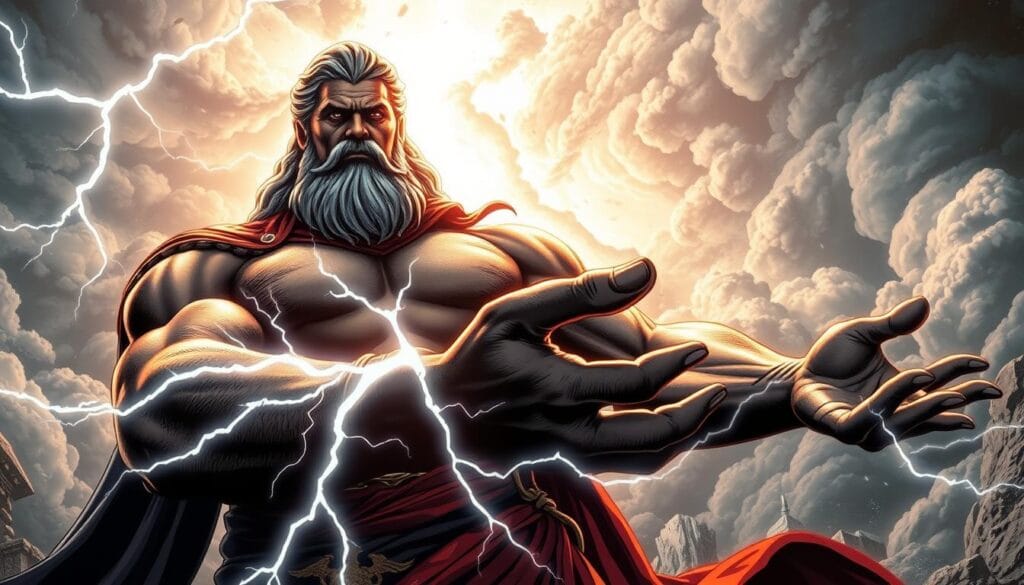
Zeus and His Thunderbolt
Zeus’s thunderbolt is the most famous divine weapon. It was made by the Cyclopes as a thank you for freeing them. This weapon showed both gratitude and incredible power.
During the Titanomachy, Zeus used his thunderbolt to show his power. It was not just about strength but also about showing who was in charge. The weapon was both a judge and an executioner, bringing justice with precision.
The thunderbolt was not just for fighting. It was also a way for Zeus to rule the gods. Its presence kept everyone in line, and its power reminded humans of their place in the world. This made it the perfect symbol of Zeus’s power and role as king of the gods.
Other Notable Thunderbolts in Mythology
Many cultures have their own versions of divine lightning weapons. Indra’s Vajra in Hindu mythology is similar to Zeus’s weapon. It shows the power of thunderstorms and enlightenment. This highlights how thunderbolt weapons often have spiritual meanings.
Thor’s Mjölnir, known as a hammer, is actually a lightning and thunder tool. Its ability to call storms and return to Thor shows the advanced nature of these divine tools. Native American traditions also talk about Thunder Beings who use lightning as a weapon and a blessing.
These stories from different cultures show a common understanding of thunder and lightning. Whether called thunderbolts, vajras, or storm hammers, these weapons help us understand the power of nature.
Tridents: The Power of the Seas
Deep in ancient myths, the trident is a legendary weapon. It commands respect and fear. Tridents are more than just tools; they are the ocean’s raw power.
Poseidon, the Greek god, had the most famous trident. It could call storms, earthquakes, and control sea creatures. These weapons were seen as both creators and destroyers.
Poseidon's Trident and Its Significance
The Cyclopes made Poseidon’s trident in their volcanic lairs. Some say Hephaestus, the divine blacksmith, created it. Either way, it became the symbol of sea power.
Poseidon’s trident could create huge tsunamis and earthquakes. It showed his powerful and unpredictable nature.
It also controlled sea life. Poseidon could call dolphins, whales, and sea monsters. This showed his total control over the sea.
But the trident could also bring life. Poseidon could make springs and rivers by striking the ground. This showed his dual nature.
Variations of Tridents in Different Mythologies
Roman mythology had Neptune, Poseidon’s Roman twin. Neptune’s trident was similar but showed Roman values of order. The Romans saw Neptune as more controlled than Poseidon.
In Hindu myths, Lord Shiva has the Trishul. It represents creation, preservation, and destruction. Unlike sea tridents, the Trishul balances the universe.
Pluto, the god of the underworld, had a bident. It had two prongs and symbolised life and death. The missing prong made it different from tridents.
| Mythology | Deity | Weapon Type | Primary Domain | Special Powers |
|---|---|---|---|---|
| Greek | Poseidon | Three-pronged Trident | Seas and Earthquakes | Storm control, creature command |
| Roman | Neptune | Three-pronged Trident | Maritime Authority | Water creation, naval protection |
| Hindu | Shiva | Trishul (Trident) | Cosmic Balance | Universal destruction and creation |
| Roman | Pluto | Two-pronged Bident | Underworld | Soul judgment, death dominion |
Celtic myths also have sea gods with trident weapons. Manannán mac Lir, the Irish sea god, had a magical trident. It could part waters and control mists.
These stories show how cultures saw tridents differently. Each added their own twist, showing the trident’s universal appeal. The three-pronged design is a common thread across cultures.
Swords of the Gods: Legends and Lore
Sacred blades in mythology are more than just weapons. They show the link between humans and gods. These legendary weapons have shaped many stories across cultures. They symbolise divine mandate and right authority.
From Arthurian legends to Japan’s sacred traditions, divine swords hold deep spiritual meaning. This goes beyond their use in battles.
The most famous godly armaments in sword form share common themes. They choose their wielders, not the other way around. These blades appear when great leaders are needed, bringing power and responsibility.
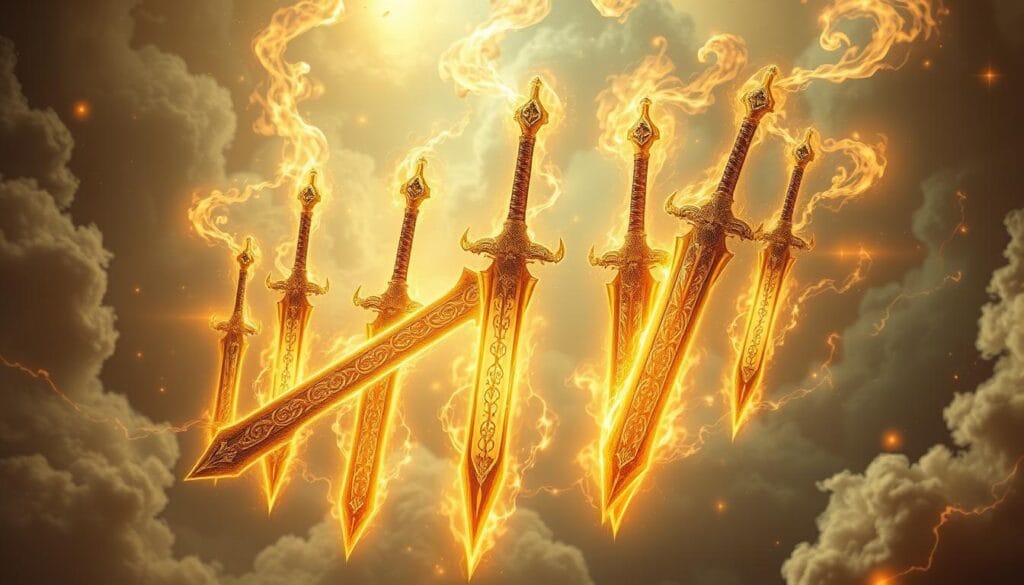
Excalibur: The Sword of King Arthur
Excalibur is the most famous legendary weapon in Western mythology. Its story has captivated people for centuries. There are two main tales about its origin.
In one, Arthur proves his right to rule by pulling the sword from a stone. In the other, the Lady of the Lake gives it to him as a gift from the mystical realm. Both stories show Excalibur’s true nature – it’s more than a weapon.
Excalibur’s importance goes beyond its ability to cut. It symbolises moral authority and the duty of just leadership. Having this sword marked Arthur as chosen by the gods, but also bound him to uphold chivalry and justice.
Kusanagi: The Grass-Cutting Sword of Japan
In Japanese mythology, Kusanagi-no-Tsurugi is a sacred godly armament. The storm god Susanoo found it in a dragon’s tail. This story shows its power over nature and evil.
Kusanagi is one of Japan’s three Imperial Regalia, along with the sacred mirror and jewel. These items show the Emperor’s divine authority and connection to Shinto deities. The sword represents valour and the right use of force in protecting the realm.
The name “grass-cutting sword” comes from a legend where Prince Yamato Takeru used it to cut away burning grass. This story highlights the sword’s protective qualities and its role in safeguarding the chosen by the gods. Unlike many legendary weapons, Kusanagi is an active symbol of imperial authority in modern Japan.
Both Excalibur and Kusanagi show how divine swords are more than physical objects. They connect earthly power with divine will. True authority comes from divine blessing and moral righteousness, not just force.
Bows and Arrows: Divine Precision
The art of divine archery is more than just hunting. It’s about justice, precision, and hitting targets from far away. These divine artifacts are among the most advanced weapons in myths. Unlike swords or spears, celestial bows let gods judge from a distance with perfect aim.
Divine archers have skills that mortals can only dream of. Their weapons often have special powers, ensuring every shot hits its mark. These ancient weapons show the balance between patience and quick action. They are the tools of gods who rule over justice and war.
The Silver Bow of the Hunt Goddess
Artemis is known as the greatest divine archer, with a silver bow made by the Cyclopes. This bow never missed, whether it was for hunting or punishing those who offended her. The Cyclopes made it alongside Zeus’s thunderbolts, making it incredibly powerful in Greek myths.
Her archery skills are famous in many myths, showing both her protective and vengeful sides. The story of Niobe’s children shows how deadly her aim could be. During the Trojan War, her arrows could change the course of battles, showing divine archery’s power.
Artemis’s bow was more than just for hunting. It was a symbol of nature’s wild side and swift justice for those who broke natural laws. Her arrows could end suffering or punish those who broke their oaths.
Sacred Bows Across World Mythologies
Apollo’s golden bow was a counterpart to Artemis’s silver one, but his arrows brought plague and disease too. These ancient weapons could spread diseases, showing divine archery’s role in biological warfare.
In Hindu myths, Rama’s archery skills were unmatched, like when he strung Shiva’s massive bow. This showed his divine strength and made him worthy of Sita and his role as Vishnu’s avatar. Rama’s arrows could split mountains and change rivers’ courses.
Norse mythology celebrates Ullr, the god of archery and winter hunting. His skills were unmatched, showing the importance of archery in surviving harsh winters. In Norse culture, archery was also tied to making promises, making these weapons sacred.
These stories show how divine artifacts like bows and arrows symbolise skill, patience, and divine favour across cultures.
Shields of the Divine: Protection and Power
Divine shields were more than just defence in ancient myths. They were mythological weapons that could protect and intimidate enemies. These shields could turn defence into a powerful attack.
These sacred divine artifacts were not just physical barriers. They showed the wisdom and power of their gods. They balanced defence and attack perfectly.
The Aegis: More Than Just Protection
Athena’s Aegis is a famous divine shield. It started with Zeus and was made by Hephaestus. This golden shield was made from polished brass.
Perseus made it even more powerful by adding Medusa’s head. This turned enemies to stone. It became a weapon of absolute power.
The Aegis became Athena’s symbol. It showed her wisdom and power in war. It was her shield and her tool for justice.
Legendary Shields Across Cultures
Many divine artifacts appeared in myths. Each had its own story and meaning. They all shared the idea of protection but were unique:
- Celtic mythology had Sgiath Gailbhinn, Fionn mac Cumhaill’s magical shield
- Norse traditions had Svalinn, a shield against the sun’s heat
- Hindu mythology mentioned Vishnu’s disc, Sudarshana Chakra, a shield and weapon
- Egyptian lore talked about Ra’s solar disc, a symbol of protection and the sun’s power
These mythological weapons showed how cultures saw divine protection. Each shield matched the values of its society. They could show bravery, protection from nature, or keeping order.
The lasting charm of divine shields is their mix of safety and strength. They teach us about the balance between defence and attack. And the importance of using power wisely.
Magical Staffs: Authority and Control
Divine staffs in mythology show their power as tools for gods. They were more than just objects; they were symbols of power. Unlike swords, staffs were about using supernatural forces with intention and will.
In ancient times, these godly armaments had many roles. They showed who was in charge, both gods and humans. They also proved who had divine favour and powers.
The Staff of Hermes: A Symbol of Communication
Hermes had a famous legendary weapon in Greek myths – the Caduceus. Zeus gave it to Hermes as a messenger. It was a way to use Hermes’ trickster side for good.
The Caduceus could control sleep with amazing accuracy. It could wake people or put them into deep sleep. This made Hermes very useful for secret missions.
Hermes also had golden winged sandals. These godly armaments helped him travel fast and control people’s awareness. Together, they made him the best messenger among gods.
The Role of Staffs in Various Mythologies
Staffs were important in many myths, each with its own meaning. Moses had a staff that could do amazing things in Judeo-Christian stories. Celtic druids used staffs to connect with nature and ancestors.
In Egyptian myths, gods held staffs to show their power. These legendary weapons showed their control over the world. They also showed the big responsibility that came with such power.
| Mythology | Staff Bearer | Primary Power | Symbolic Meaning |
|---|---|---|---|
| Greek | Hermes | Sleep Control | Divine Communication |
| Egyptian | Thoth | Wisdom Channelling | Knowledge Authority |
| Celtic | Druids | Nature Connection | Spiritual Leadership |
| Norse | Odin | Runic Magic | Ultimate Wisdom |
These divine tools showed how to use supernatural power with will. They were bridges between humans and gods. They let their users control forces beyond our understanding.
Armour of the Gods: Divine Protection
Divine armour was a mix of protection and art in ancient myths. It was more than just defence; it showed the gods’ power and status. Ancient weapons and armour made by gods had magic that regular metal didn’t.
The armour of gods and heroes showed their divine side. It was made with skill that humans couldn’t match. These items often decided the fate of great battles and quests.
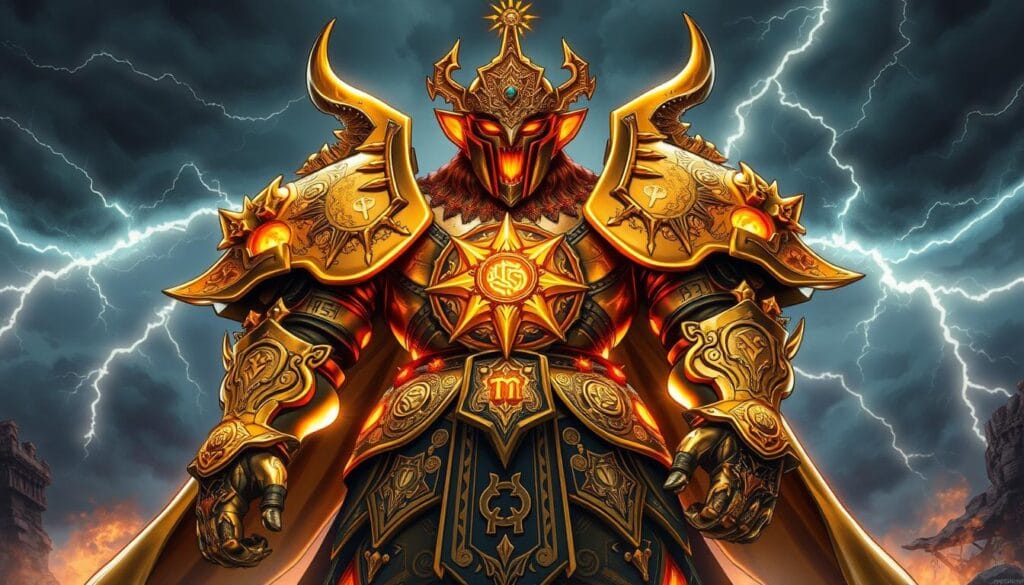
Hephaestus and the Creation of Divine Armour
Hephaestus, the god of Mount Olympus, was the top armour maker. His work was both strong and beautiful. His creations were the best in the ancient world.
Hephaestus made Achilles’ famous armour. Homer’s Iliad tells us it was amazing, with a shield showing the whole world. This armour was the best of divine craftsmanship, with scenes of peace and war.
Hephaestus also made gear for the gods. He made Zeus’s aegis and Poseidon’s battle gear. Each piece showed the god’s powers and duties.
Hephaestus’s work was special. He added magic to his armour. It could stop any mortal weapon and gave extra powers to the wearer.
Armour in Other Mythological Narratives
Mythological weapons and armour are found in many cultures. Each shows different beliefs about divine protection. Celtic myths have mail shirts that made wearers invincible. These shirts had special rules or curses.
Norse myths also have amazing armour. The gods of Asgard wore gear that could block giant and monster attacks. Odin’s horse Sleipnir had divine barding, and Odin wore armour that showed his role as the All-Father.
The Mahabharata tells of divine armour in Hindu myths. Warriors got gear from gods, like Karna’s natural armour. This armour was very powerful but also had sad consequences.
Japanese myths also have divine armour. This gear was made with spiritual elements. It protected the wearer from evil spirits. These ancient weapons and armour are key in many stories.
| Mythology | Divine Armour | Special Properties | Notable Wearer |
|---|---|---|---|
| Greek | Achilles’ Armour | Cosmic shield, unbreakable defence | Achilles |
| Celtic | Invincible Mail Shirts | Complete invulnerability | Various heroes |
| Norse | Asgardian Battle Gear | Giant-proof protection | Norse gods |
| Hindu | Karna’s Natural Armour | Born-in protection, divine gift | Karna |
| Japanese | Spirit-Ward Armour | Protection against evil spirits | Legendary warriors |
Making divine armour needed rare materials and magic. Many myths tell of quests for these materials. These stories show the amazing nature of divine protection.
Divine armour did more than protect. It showed the wearer’s status and divine favour. The bearer of such mythological weapons and armour had special duties.
These legendary pieces inspire us today. They show what divine power and protection mean. Their influence is seen in many stories and ideas today.
The Symbolism Behind Divine Weapons
Throughout history, divine weapons have been symbols of cosmic order and spiritual authority. These legendary armaments went beyond their practical use. They became symbols that shaped entire civilisations. Divine Artifacts were more than tools of war; they were the essence of divine power and cosmic balance.
These weapons showed how ancient cultures saw power and responsibility. Each weapon, like a blade or trident, carried deep meanings. They connected the physical and spiritual worlds. These mythical tools defined their wielders’ identities and roles in the cosmos.
Weapons as Symbols of Power and Authority
The Weapons of the Gods were symbols of true authority and divine mandate. Who had these weapons showed a deity’s status in their pantheon. Losing or stealing these weapons could change the cosmic power balance.
These divine tools stood for rightful rule and cosmic justice. Zeus’s thunderbolt, for example, was not just for destruction. It was about keeping order among gods and mortals. The weapon chose its wielder, creating a sacred bond that legitimized divine authority.
With such power came great responsibility. Divine Artifacts tested their bearers’ wisdom and restraint. This idea shaped how ancient societies viewed leadership and the moral duties of those in power.
| Divine Weapon | Symbolic Meaning | Authority Represented | Cultural Impact |
|---|---|---|---|
| Zeus’s Thunderbolt | Divine Justice | Supreme Cosmic Rule | Foundation of Western concepts of divine authority |
| Poseidon’s Trident | Dominion over Waters | Control of Natural Forces | Maritime cultures’ understanding of divine power |
| Excalibur | Rightful Kingship | Legitimate Earthly Rule | Medieval concepts of divine right to rule |
| Mjolnir | Protection and Strength | Defender of Order | Norse ideals of heroic responsibility |
The Role of Weapons in Religious Practices
Religious ceremonies worldwide used The Weapons of the Gods as symbols of worship and spiritual connection. These sacred tools appeared in temple art and rituals. They helped worshippers connect with the divine.
These weapons had deep symbolic power in meditation and spiritual growth. Practitioners imagined wielding divine weapons to connect with higher powers. This practice turned the weapons into spiritual tools for personal growth.
Divine Artifacts also influenced the design of religious objects. Temple swords and ritual staffs were inspired by mythological weapons. They connected earthly worship to divine power.
Today, these symbols are part of many faiths. Modern beliefs use imagery and ideas from mythological weapons. These symbols speak to universal human experiences of power, responsibility, and spiritual aspiration.
The lasting appeal of these mythical weapons shows their deep impact on human thought. They link us to a rich history of legend and spiritual wisdom. Divine Artifacts make mythology a living tradition that guides our understanding of power, authority, and spiritual truth.
Modern Interpretations of Ancient Weapons
Ancient divine weapons have found new life in today’s entertainment. These legendary weapons inspire creators and captivate audiences worldwide. They appear in blockbuster films and bestselling novels, showing their timeless appeal.
Modern entertainment has given new life to ancient myths. Today’s audiences connect with these symbols through fresh stories and perspectives. This new approach makes these classics relatable and exciting.
Influence on Pop Culture
Marvel’s movies have changed how we see mythological weapons. Thor’s Mjölnir is now a symbol of heroism, known by many. Its design and powers have inspired countless items, from jewellery to collectibles.
Video games have also embraced divine weapons creatively. The God of War series lets players use mythological weapons. Assassin’s Creed blends ancient weapons with history, making games interactive and educational.

Literature has also reimagined these ancient tools. Fantasy novels often feature legendary weapons as key elements. Authors like Rick Riordan introduce these weapons to younger readers through engaging stories.
Cinema has turned divine armaments into visual wonders. Poseidon’s trident appears in various films, from animated to epic adventures. These weapons symbolise power, justice, and the supernatural.
| Media Type | Popular Examples | Weapon Featured | Cultural Impact |
|---|---|---|---|
| Films | Thor, Aquaman, Wonder Woman | Mjölnir, Trident, Lasso | Global recognition |
| Video Games | God of War, Assassin’s Creed | Blades of Chaos, Various | Interactive engagement |
| Literature | Percy Jackson series | Riptide, Various | Educational entertainment |
| Comics | Marvel, DC Universe | Multiple divine weapons | Character development |
The Continued Fascination with Mythological Weapons
The appeal of mythological weapons is rooted in human desires. They symbolise power, justice, and a connection to something greater. In today’s world, people seek these qualities.
Studies show that legendary weapons meet deep needs for empowerment and meaning. They offer symbols of courage, wisdom, and divine favour. This is why they remain popular across generations.
Creators know that legendary weapons are powerful in storytelling. They represent growth, responsibility, and the weight of power. These themes resonate with today’s audiences facing their own challenges.
The craftsmanship and artistry of divine weapons also fascinate today’s audience. Detailed recreations and artistic interpretations celebrate both ancient mythology and modern creativity. This blend creates a new appreciation for history while entertaining today’s viewers.
Social media has made mythological weapons more popular through fan communities and creative content. Fans share artwork, theories, and discussions about their favourite divine armaments. This digital engagement keeps these ancient symbols relevant today.
Conclusion: Legacy and Impact of Divine Weapons
The fascination with mythological weapons shows a deep part of human nature. These legendary tools have captured hearts for generations. They connect ancient wisdom with today’s dreams.
Ancient Weaponry in Contemporary Society
Mythical weapons have made a lasting impact on our world. You see them in logos and buildings, showing their influence. Movies also use these symbols to tell stories that reach people everywhere.
Many national symbols include parts of these legendary weapons. Art keeps exploring the themes of power and duty through them. These symbols also shape our views on leadership and right action today.
Timeless Appeal of Mythological Power
These mythical weapons remind us of the lasting power of old stories. They connect us to a deep history and legend. Mythology is not just a subject to study but a treasure to enjoy.
These weapons show our endless search for power and how to use it right. They teach us about leading with care and inspire us to think about justice and leadership. These legendary tools will keep shaping our culture for many years.
FAQ
What are divine weapons and why were they important in ancient mythologies?
Divine weapons were legendary tools used by gods and deities. They were more than just weapons; they symbolised divine power and cultural identity. These weapons showed the essence of their gods and played key roles in ancient societies.
What makes Zeus’s thunderbolt so significant among divine weapons?
Zeus’s thunderbolt is a powerful symbol in Greek mythology. Made by the Cyclopes, it showed Zeus’s power and temper. It was feared and respected, embodying divine wrath and power.
How does Poseidon’s trident differ from other divine weapons?
Poseidon’s trident is special because it controls the seas. Made by the Cyclopes or Hephaestus, it has powers like storm control and sea creature command. It shows the power of water, unlike other weapons.
What is the significance of Excalibur in Arthurian legend?
Excalibur is more than a sword; it’s a symbol of rightful kingship. It proves a king’s authority and moral rightness. This sword shows true leadership comes with divine blessing and responsibility.
Why were bows and arrows considered divine weapons?
Bows and arrows symbolised precision and divine justice. Artemis’s silver bow, for example, showed unmatched accuracy. These weapons allowed gods to strike with mercy or retribution, making archery a divine skill.
What made Athena’s Aegis more than just a protective shield?
Athena’s Aegis was originally Zeus’s shield, but it became powerful when adorned with Medusa’s head. It could turn enemies to stone, blending defence and offence. It showed Athena’s strategic thinking and divine authority.
What powers did Hermes’ Caduceus possess?
Hermes’ Caduceus controlled sleep and wakefulness, symbolising divine messengership. It showed Hermes’ role in commerce and communication. This staff channelled supernatural power, essential for divine messages.
How did Hephaestus contribute to divine weaponry?
Hephaestus, the divine blacksmith, crafted legendary armour and weapons. His work included Achilles’ armour and the Olympians’ gear. His creations were symbols of divine art and protection.
What symbolic meanings do divine weapons carry beyond their practical functions?
Divine weapons were more than tools; they symbolised authority and cosmic order. They showed a deity’s status and the responsibility of power. These weapons often chose their wielders, not the other way around.
How do divine weapons appear in modern popular culture?
Divine weapons captivate audiences in media like Marvel’s Thor and video games like God of War. These stories reimagine ancient legends, exploring themes of empowerment and justice.
Are there similarities between thunder weapons across different cultures?
Yes, thunderbolt weapons are similar worldwide, like Indra’s Vajra and Thor’s Mjölnir. They symbolise divine wrath and power, making them feared and respected across cultures.
What role did divine weapons play in ancient religious practices?
Divine weapons were central to ancient worship and spiritual practices. They appeared in rituals and art, connecting mortals to the divine. These weapons continue to influence faiths today.
